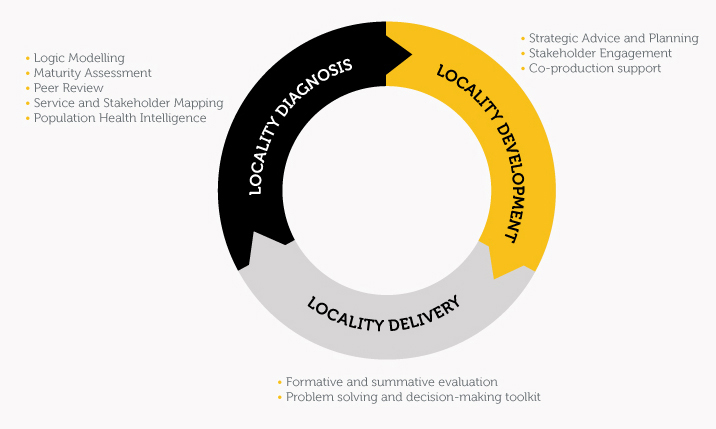The role of localities in place-based working
In recent years the notion of ‘place’ has become increasingly important in health and care policy. The fundamental notion being that thinking about ‘a place’ when planning and delivering services can be helpful to the task of integrating care (and thereby improving resource use, outcomes and experience).
While not new to those in Local Authorities – or those in economic development, regeneration or spatial planning – the NHS is still articulating what ‘place-based’ really means in healthcare. The NHS’ place-based agenda is being developed at different levels and through different structures. This is illustrated in the diagram, which shows that:
- Below the national level, ‘Sustainability and Transformation Partnerships’ (STPs) - and their more mature cousins ‘Integrated Care Systems’ (ICSs) – have been established to integrate care (primarily within health services and between health and social care services) at sub-national level. There are currently 44 STPs and 11 ICSs. They operate at populations of between the mid-high hundreds of thousands to the low millions;
- For the most part, the level below this is occupied by Clinical Commissioning Groups (CCGs) and Local Authorities (LAs). Depending on other developments, there may also be Accountable Care Organisations (ACOs) at this level too. These organisations are responsible for places with populations between the low to high hundreds of thousands;
- Below this level is the locality or neighbourhood, which is the focus of this paper. Their scale varies, but localities tend to act at the 30,000 to 100,000 population level. Relative to many of the levels summarised above there is more prospect of stability and longevity in locality working (perhaps because they are several steps removed from national policy). These are important conditions to better integration; they also explain part of the Strategy Unit’s enthusiasm for supporting locality working.

What’s in a name?
While there have been specific programmes to encourage their development, it is perhaps better to think of locality working as having evolved. And, while far from being universal, some form of locality-based working seems to be at the heart of most strategies and care models.
Yet commonality does not translate into uniformity and there is no single or accepted blueprint for ‘a locality’. Even the terminology used suggests this and what we call a ‘locality’ goes by many names (an incomplete list of the terms we have encountered is set out).
| Integrated Locality Team Primary Care Hub Health and Social Care Hub Neighbourhood Team Primary Care Home |
Integrated Care Hub Integrated Local Care Team Practice Integrated Care Team Enhanced Primary Care Community Hub |
Primary Care Neighbourhood Model Integrated Community Team Primary Care Network Integrated Neighbourhood Team |
This terminological variety is also reflected in practice and locality-based working takes many forms.
The figure attempts to provide a framework for understanding this.
It shows that it is possible to categorise localities according to the population groups targeted (from people with complex needs to everyone in the area) and the services included (from just health services up to a wide range of different public and voluntary services).

Notwithstanding the variety described above, our work suggests a series of core features across most forms of locality. These are summarised in the diagram.

Partnering with the Strategy Unit to make the most of locality-based working
We are enthused by locality working. So we want to use our expertise to make the most of it. We have already worked successfully with organisations developing their own ‘locality’ model, helping them to understand their requirements and bridge the gap between policy and practice. We are committed to this work and will establish a Locality Network in the summer of 2018 to encourage debate and solutions in this area.
So what might we do? Our services span the innovation and improvement cycle. We help our customers understand challenges, design responses, improve delivery, and evaluate results. In short, we help them ‘Diagnose’, ‘Develop’ and ‘Deliver’. In helping to improve locality working, this might mean:
The Strategy Unit works on complex challenges. Our services add most value where the need for innovation and clear thinking is high and the suitability of standard approaches is low. So, in all cases, our support is tailored to the specific needs of the organisations and systems we work with.
We have no ‘standard offer’ for localities and would work to understand and address your specific needs. We blend our technical expertise with the local knowledge of our customers, enhancing the organisations, teams and systems we work with. This will be vital for improving skills in localities and equipping teams with the skills they need to self-improve and to thrive.
